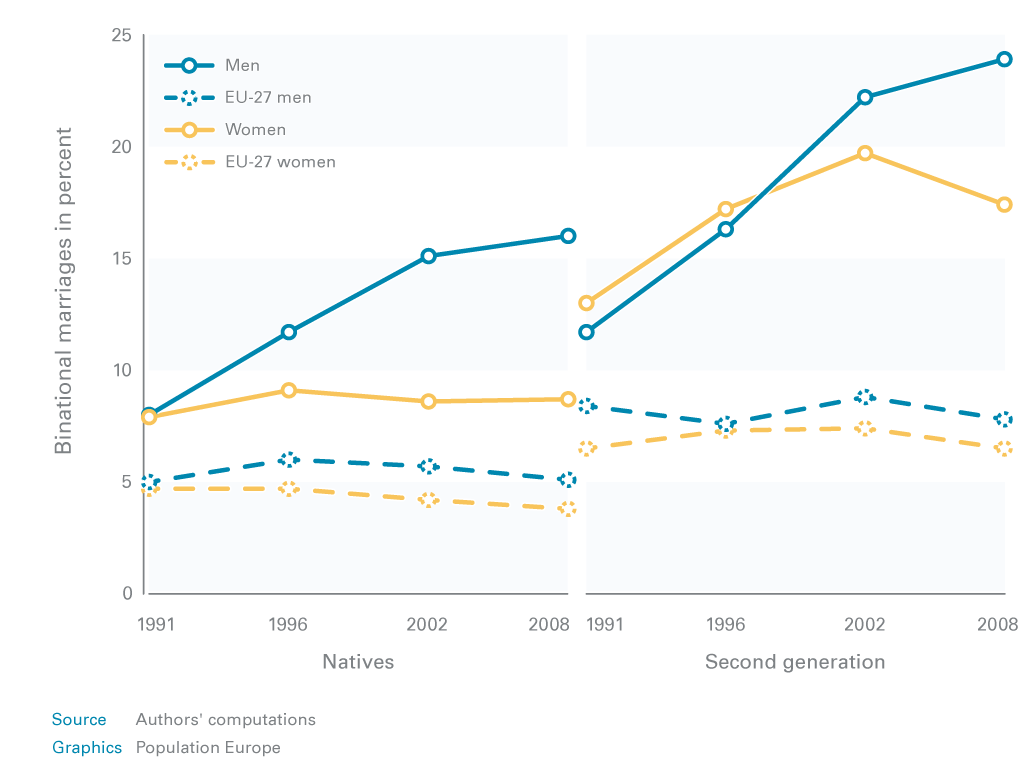Not only has the opening of EU borders led to an expansion of partner markets in Sweden, but globalisation, a general increase in diversity and a growing number of Swedes who travel, work or study abroad have also played a role. Karen Haandrikman from Stockholm University explored and tried to explain the complex patterns of partner choice in Sweden. She also tried to find out if there is an EU effect, meaning if the expansion of the EU did play a significant role.
Exploring a pattern of partner choice
Haandrikman focused on the characteristics of native Swedes who marry foreign partners, and she tried to systematically identify how those who marry partners from abroad differ from each other. Her aim was to explore and explain the partner choice of Swedes between 1990 and 2008 with a special focus on those choosing EU partners as opposed to those choosing Swedish partners or partners from outside the EU. By comparing natives with Swedish-born parents to those with parents from abroad, she also took into account the possible influence of foreign-born parents on partner choice. Using full population register data, Haandrikman conducted a systematic comparison between Swedes marrying EU partners and those marrying non-EU partners.
Highly gender specific
She found that the rate of binational marriages in Sweden has increased in the last years, especially for men and for second generation Swedes. The most obvious result when comparing the two sexes is that men are increasingly marrying binationally. For native men, the share of binational marriages has increased from 8% in 1991 to 16% in 2008 whereas the same share only increased slightly for native women, from 8% to 9% in the same period (Figure 1). This increase is mainly happening due to an increase in marriages to partners from outside the EU. Whereas binational EU marriages have remained stable.

Figure 1: Percentages of binational marriages among all marriages by sex, 1991-2008
Where are they from?
When it comes to the countries of origin of the partners of choice, the results are highly gender-specific. Interestingly, for women proximity seems to be much more important than for men. Swedish women mostly marry Finnish men, whereas Thai women are popular with Swedish men. For men, the dynamics regarding the most popular countries of origin of foreign partners changed considerably since the beginning of the 1990s, while the pattern for women remained stable. Native men used to primarily chose European and American women, and the top three choices were completely Scandinavian. From 2002 onwards, marriages to eastern European and Asian women have become increasingly common, with Thai wives being even more common than Finnish wives. A different picture applies to Swedish women, however. Finland has been and continues to be the principal supplier of husbands. Swedish women have also always favoured western husbands, especially Nordic, British, and American partners, and they still do.
The second generation
Having a look at Swedes whose parents are migrants, Haandrikman found that since 1996, second generation men increasingly marry Yugoslavian and Turkish women. At that point in time these migrant groups were becoming more numerous in Sweden. But apart from that, Swedish men with at least one parent from one of the countries mentioned above show the same marriage patterns as native Swedes. They also prefer Thai women.
The case is different for second generation women. They also marry Finnish men, but most husbands came from the former Yugoslavia and from Turkey. Their parents came to Sweden years ago, and even though the daughters were born in Sweden, they prefer partners from their parents home country.
No EU Effect
Haandrikmans study filled a gap in existing literature, examining the tendency of Swedes to marry foreign partners. Increased travelling, living abroad, transnational networks, internet usage, and a more diverse migrant population have led to increased opportunities for meeting foreign partners. That is why in Sweden the probability of marrying a foreign partner has doubled for native women, and nearly quadrupled for native men in less than 20 years.
But when asking for an EU effect, Haandrikman tends to give a negative answer. There are no hard facts to prove that Sweden’s accession to the EU has led to more “Euromarriages” and it is impossible to say how the trend of marrying partners from Eastern and Central Europe would have continued without the EU enlargement.
This PopDigest is also available in French, Spanish and German.
This Population Digest has been published with financial support from the Progress Programme of the European Union in the framework of the project “Supporting a Partnership for Enhancing Europe’s Capacity to Tackle Demographic and Societal Change”.